Jianhao Ding
Proxy Target: Bridging the Gap Between Discrete Spiking Neural Networks and Continuous Control
May 30, 2025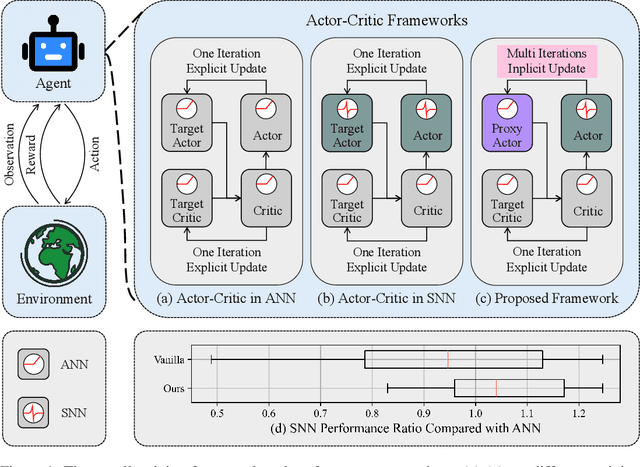



Abstract:Spiking Neural Networks (SNNs) offer low-latency and energy-efficient decision making through neuromorphic hardware, making them compelling for Reinforcement Learning (RL) in resource-constrained edge devices. Recent studies in this field directly replace Artificial Neural Networks (ANNs) by SNNs in existing RL frameworks, overlooking whether the RL algorithm is suitable for SNNs. However, most RL algorithms in continuous control are designed tailored to ANNs, including the target network soft updates mechanism, which conflict with the discrete, non-differentiable dynamics of SNN spikes. We identify that this mismatch destabilizes SNN training in continuous control tasks. To bridge this gap between discrete SNN and continuous control, we propose a novel proxy target framework. The continuous and differentiable dynamics of the proxy target enable smooth updates, bypassing the incompatibility of SNN spikes, stabilizing the RL algorithms. Since the proxy network operates only during training, the SNN retains its energy efficiency during deployment without inference overhead. Extensive experiments on continuous control benchmarks demonstrate that compared to vanilla SNNs, the proxy target framework enables SNNs to achieve up to 32% higher performance across different spiking neurons. Notably, we are the first to surpass ANN performance in continuous control with simple Leaky-Integrate-and-Fire (LIF) neurons. This work motivates a new class of SNN-friendly RL algorithms tailored to SNN's characteristics, paving the way for neuromorphic agents that combine high performance with low power consumption.
Towards High-performance Spiking Transformers from ANN to SNN Conversion
Feb 28, 2025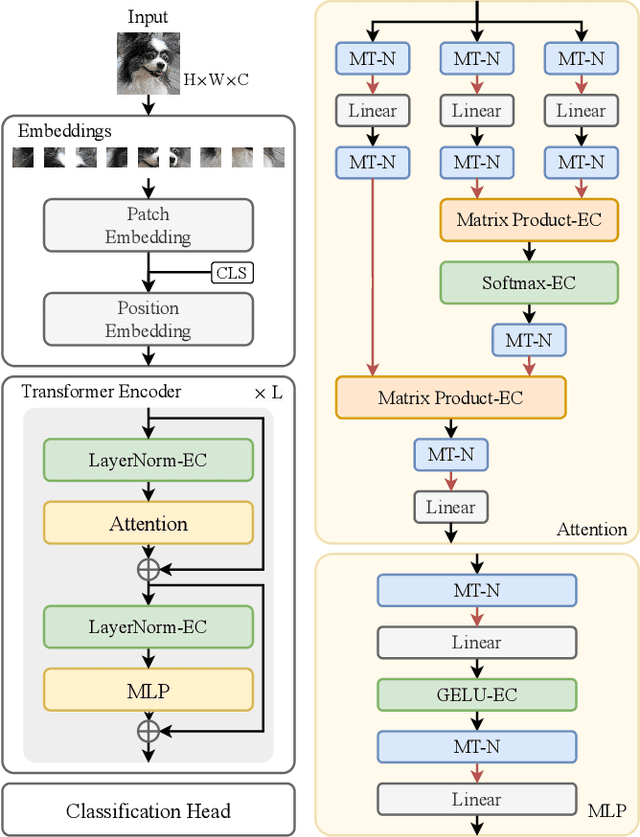
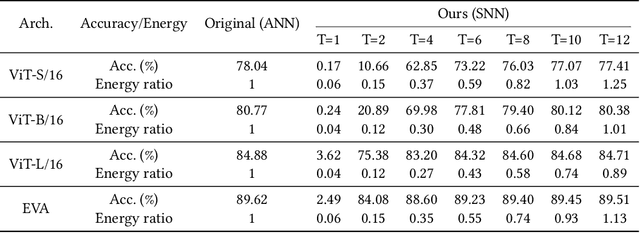
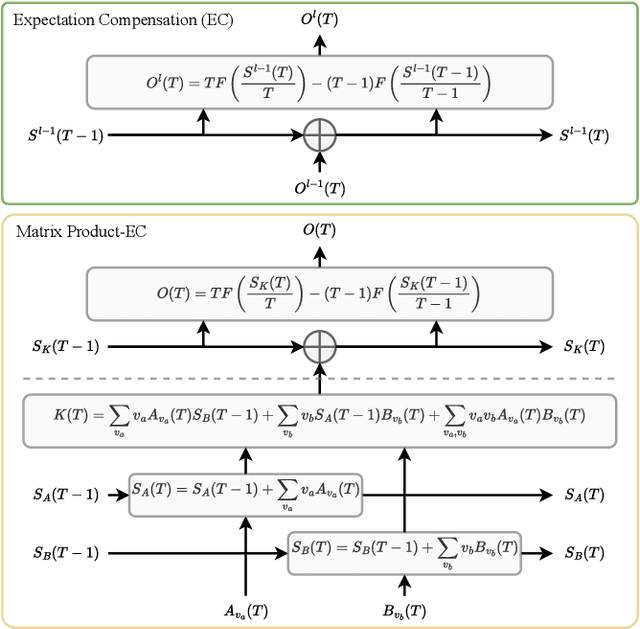
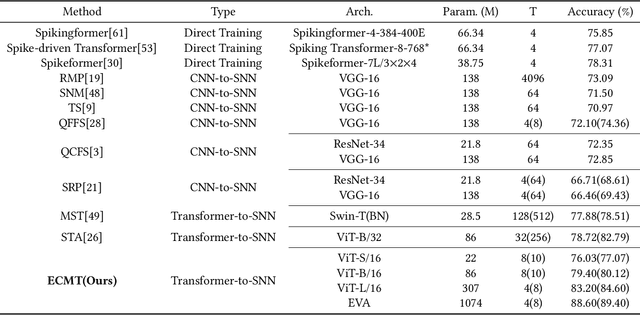
Abstract:Spiking neural networks (SNNs) show great potential due to their energy efficiency, fast processing capabilities, and robustness. There are two main approaches to constructing SNNs. Direct training methods require much memory, while conversion methods offer a simpler and more efficient option. However, current conversion methods mainly focus on converting convolutional neural networks (CNNs) to SNNs. Converting Transformers to SNN is challenging because of the presence of non-linear modules. In this paper, we propose an Expectation Compensation Module to preserve the accuracy of the conversion. The core idea is to use information from the previous T time-steps to calculate the expected output at time-step T. We also propose a Multi-Threshold Neuron and the corresponding Parallel Parameter normalization to address the challenge of large time steps needed for high accuracy, aiming to reduce network latency and power consumption. Our experimental results demonstrate that our approach achieves state-of-the-art performance. For example, we achieve a top-1 accuracy of 88.60\% with only a 1\% loss in accuracy using 4 time steps while consuming only 35\% of the original power of the Transformer. To our knowledge, this is the first successful Artificial Neural Network (ANN) to SNN conversion for Spiking Transformers that achieves high accuracy, low latency, and low power consumption on complex datasets. The source codes of the proposed method are available at https://github.com/h-z-h-cell/Transformer-to-SNN-ECMT.
Robust Stable Spiking Neural Networks
May 31, 2024
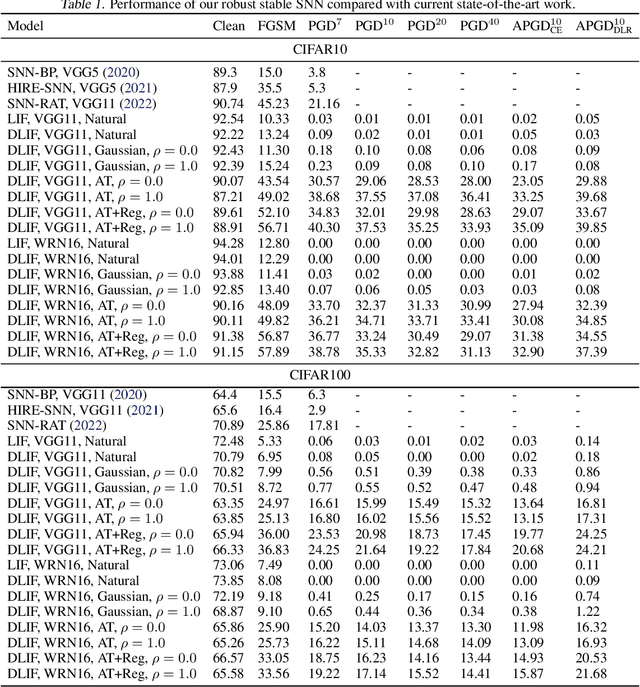
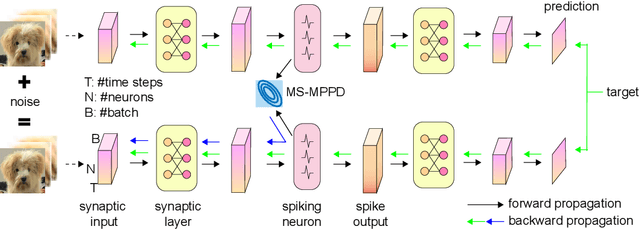
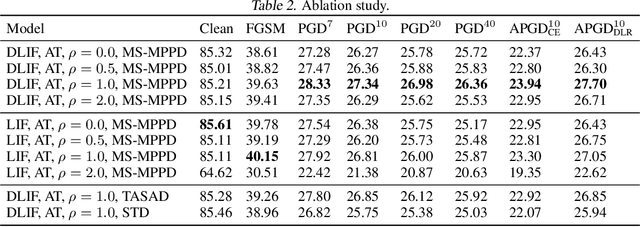
Abstract:Spiking neural networks (SNNs) are gaining popularity in deep learning due to their low energy budget on neuromorphic hardware. However, they still face challenges in lacking sufficient robustness to guard safety-critical applications such as autonomous driving. Many studies have been conducted to defend SNNs from the threat of adversarial attacks. This paper aims to uncover the robustness of SNN through the lens of the stability of nonlinear systems. We are inspired by the fact that searching for parameters altering the leaky integrate-and-fire dynamics can enhance their robustness. Thus, we dive into the dynamics of membrane potential perturbation and simplify the formulation of the dynamics. We present that membrane potential perturbation dynamics can reliably convey the intensity of perturbation. Our theoretical analyses imply that the simplified perturbation dynamics satisfy input-output stability. Thus, we propose a training framework with modified SNN neurons and to reduce the mean square of membrane potential perturbation aiming at enhancing the robustness of SNN. Finally, we experimentally verify the effectiveness of the framework in the setting of Gaussian noise training and adversarial training on the image classification task.
Enhancing Adversarial Robustness in SNNs with Sparse Gradients
May 30, 2024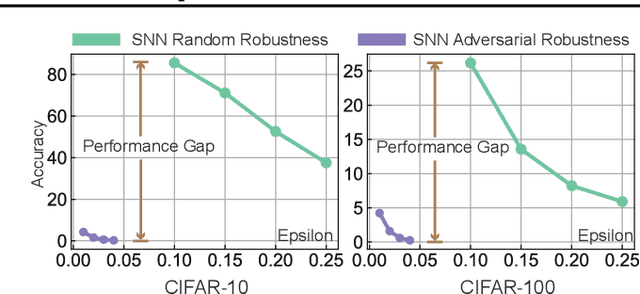


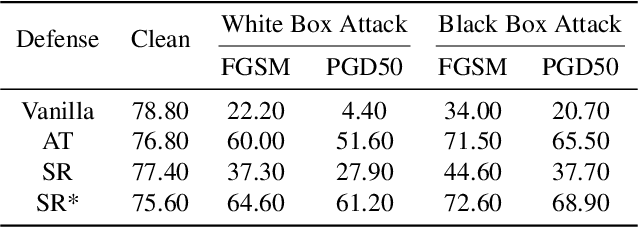
Abstract:Spiking Neural Networks (SNNs) have attracted great attention for their energy-efficient operations and biologically inspired structures, offering potential advantages over Artificial Neural Networks (ANNs) in terms of energy efficiency and interpretability. Nonetheless, similar to ANNs, the robustness of SNNs remains a challenge, especially when facing adversarial attacks. Existing techniques, whether adapted from ANNs or specifically designed for SNNs, exhibit limitations in training SNNs or defending against strong attacks. In this paper, we propose a novel approach to enhance the robustness of SNNs through gradient sparsity regularization. We observe that SNNs exhibit greater resilience to random perturbations compared to adversarial perturbations, even at larger scales. Motivated by this, we aim to narrow the gap between SNNs under adversarial and random perturbations, thereby improving their overall robustness. To achieve this, we theoretically prove that this performance gap is upper bounded by the gradient sparsity of the probability associated with the true label concerning the input image, laying the groundwork for a practical strategy to train robust SNNs by regularizing the gradient sparsity. We validate the effectiveness of our approach through extensive experiments on both image-based and event-based datasets. The results demonstrate notable improvements in the robustness of SNNs. Our work highlights the importance of gradient sparsity in SNNs and its role in enhancing robustness.
Converting High-Performance and Low-Latency SNNs through Explicit Modelling of Residual Error in ANNs
Apr 26, 2024



Abstract:Spiking neural networks (SNNs) have garnered interest due to their energy efficiency and superior effectiveness on neuromorphic chips compared with traditional artificial neural networks (ANNs). One of the mainstream approaches to implementing deep SNNs is the ANN-SNN conversion, which integrates the efficient training strategy of ANNs with the energy-saving potential and fast inference capability of SNNs. However, under extreme low-latency conditions, the existing conversion theory suggests that the problem of misrepresentation of residual membrane potentials in SNNs, i.e., the inability of IF neurons with a reset-by-subtraction mechanism to respond to residual membrane potentials beyond the range from resting potential to threshold, leads to a performance gap in the converted SNNs compared to the original ANNs. This severely limits the possibility of practical application of SNNs on delay-sensitive edge devices. Existing conversion methods addressing this problem usually involve modifying the state of the conversion spiking neurons. However, these methods do not consider their adaptability and compatibility with neuromorphic chips. We propose a new approach based on explicit modeling of residual errors as additive noise. The noise is incorporated into the activation function of the source ANN, which effectively reduces the residual error. Our experiments on the CIFAR10/100 dataset verify that our approach exceeds the prevailing ANN-SNN conversion methods and directly trained SNNs concerning accuracy and the required time steps. Overall, our method provides new ideas for improving SNN performance under ultra-low-latency conditions and is expected to promote practical neuromorphic hardware applications for further development.
Defense Against Adversarial Attacks on No-Reference Image Quality Models with Gradient Norm Regularization
Mar 18, 2024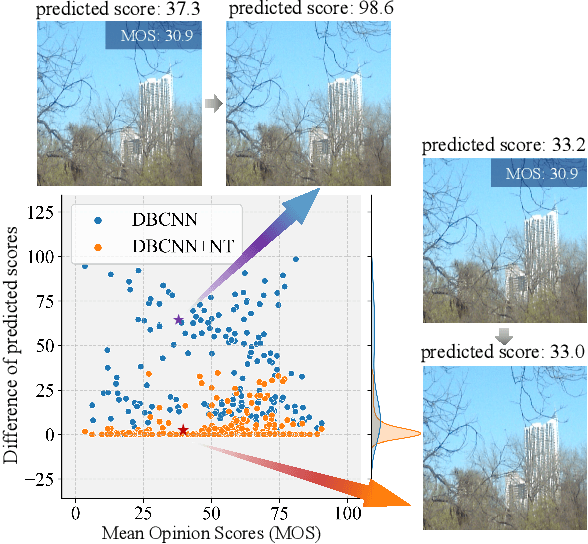



Abstract:The task of No-Reference Image Quality Assessment (NR-IQA) is to estimate the quality score of an input image without additional information. NR-IQA models play a crucial role in the media industry, aiding in performance evaluation and optimization guidance. However, these models are found to be vulnerable to adversarial attacks, which introduce imperceptible perturbations to input images, resulting in significant changes in predicted scores. In this paper, we propose a defense method to improve the stability in predicted scores when attacked by small perturbations, thus enhancing the adversarial robustness of NR-IQA models. To be specific, we present theoretical evidence showing that the magnitude of score changes is related to the $\ell_1$ norm of the model's gradient with respect to the input image. Building upon this theoretical foundation, we propose a norm regularization training strategy aimed at reducing the $\ell_1$ norm of the gradient, thereby boosting the robustness of NR-IQA models. Experiments conducted on four NR-IQA baseline models demonstrate the effectiveness of our strategy in reducing score changes in the presence of adversarial attacks. To the best of our knowledge, this work marks the first attempt to defend against adversarial attacks on NR-IQA models. Our study offers valuable insights into the adversarial robustness of NR-IQA models and provides a foundation for future research in this area.
SpikingJelly: An open-source machine learning infrastructure platform for spike-based intelligence
Oct 25, 2023Abstract:Spiking neural networks (SNNs) aim to realize brain-inspired intelligence on neuromorphic chips with high energy efficiency by introducing neural dynamics and spike properties. As the emerging spiking deep learning paradigm attracts increasing interest, traditional programming frameworks cannot meet the demands of the automatic differentiation, parallel computation acceleration, and high integration of processing neuromorphic datasets and deployment. In this work, we present the SpikingJelly framework to address the aforementioned dilemma. We contribute a full-stack toolkit for pre-processing neuromorphic datasets, building deep SNNs, optimizing their parameters, and deploying SNNs on neuromorphic chips. Compared to existing methods, the training of deep SNNs can be accelerated $11\times$, and the superior extensibility and flexibility of SpikingJelly enable users to accelerate custom models at low costs through multilevel inheritance and semiautomatic code generation. SpikingJelly paves the way for synthesizing truly energy-efficient SNN-based machine intelligence systems, which will enrich the ecology of neuromorphic computing.
Spike timing reshapes robustness against attacks in spiking neural networks
Jun 09, 2023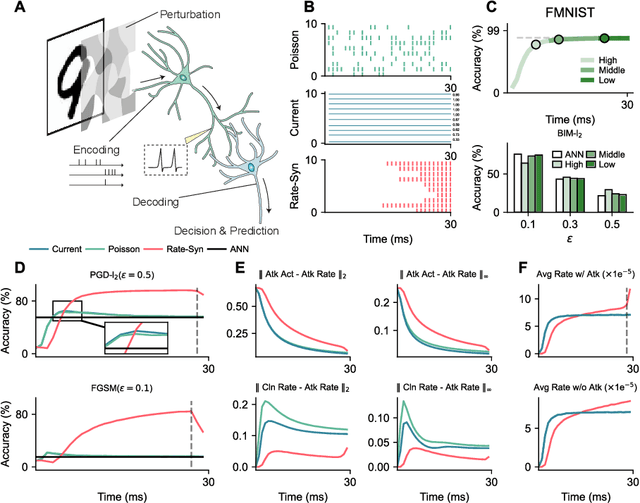
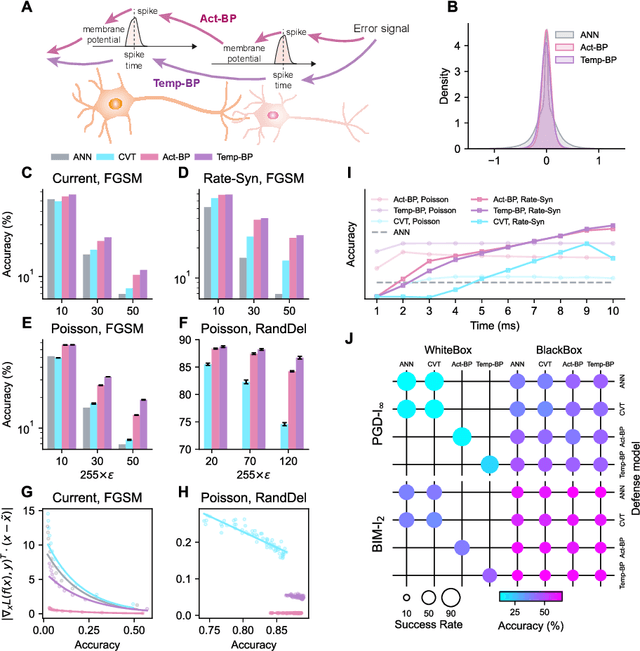
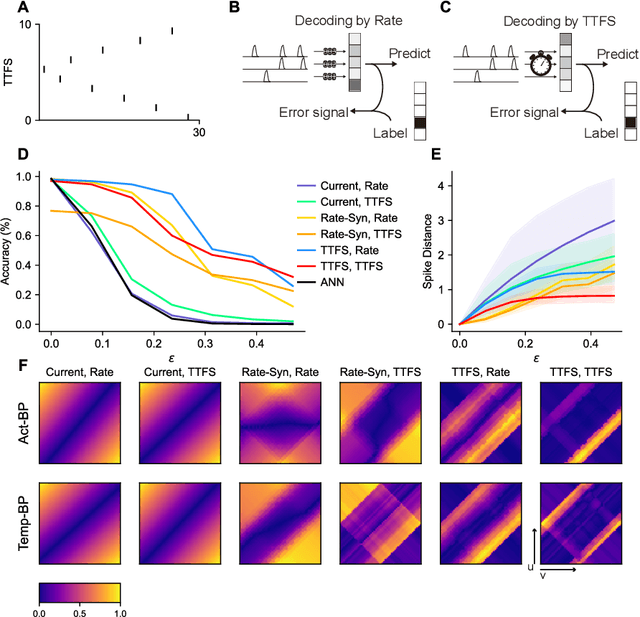
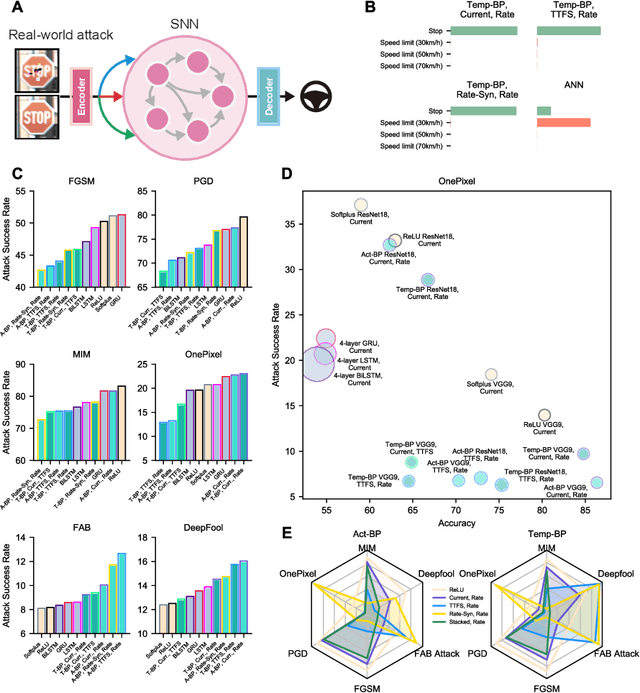
Abstract:The success of deep learning in the past decade is partially shrouded in the shadow of adversarial attacks. In contrast, the brain is far more robust at complex cognitive tasks. Utilizing the advantage that neurons in the brain communicate via spikes, spiking neural networks (SNNs) are emerging as a new type of neural network model, boosting the frontier of theoretical investigation and empirical application of artificial neural networks and deep learning. Neuroscience research proposes that the precise timing of neural spikes plays an important role in the information coding and sensory processing of the biological brain. However, the role of spike timing in SNNs is less considered and far from understood. Here we systematically explored the timing mechanism of spike coding in SNNs, focusing on the robustness of the system against various types of attacks. We found that SNNs can achieve higher robustness improvement using the coding principle of precise spike timing in neural encoding and decoding, facilitated by different learning rules. Our results suggest that the utility of spike timing coding in SNNs could improve the robustness against attacks, providing a new approach to reliable coding principles for developing next-generation brain-inspired deep learning.
SpikeCV: Open a Continuous Computer Vision Era
Mar 21, 2023



Abstract:SpikeCV is a new open-source computer vision platform for the spike camera, which is a neuromorphic visual sensor that has developed rapidly in recent years. In the spike camera, each pixel position directly accumulates the light intensity and asynchronously fires spikes. The output binary spikes can reach a frequency of 40,000 Hz. As a new type of visual expression, spike sequence has high spatiotemporal completeness and preserves the continuous visual information of the external world. Taking advantage of the low latency and high dynamic range of the spike camera, many spike-based algorithms have made significant progress, such as high-quality imaging and ultra-high-speed target detection. To build up a community ecology for the spike vision to facilitate more users to take advantage of the spike camera, SpikeCV provides a variety of ultra-high-speed scene datasets, hardware interfaces, and an easy-to-use modules library. SpikeCV focuses on encapsulation for spike data, standardization for dataset interfaces, modularization for vision tasks, and real-time applications for challenging scenes. With the advent of the open-source Python ecosystem, modules of SpikeCV can be used as a Python library to fulfilled most of the numerical analysis needs of researchers. We demonstrate the efficiency of the SpikeCV on offline inference and real-time applications. The project repository address are \url{https://openi.pcl.ac.cn/Cordium/SpikeCV} and \url{https://github.com/Zyj061/SpikeCV
Optimal ANN-SNN Conversion for High-accuracy and Ultra-low-latency Spiking Neural Networks
Mar 08, 2023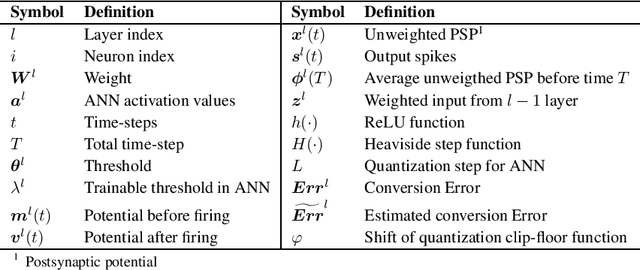


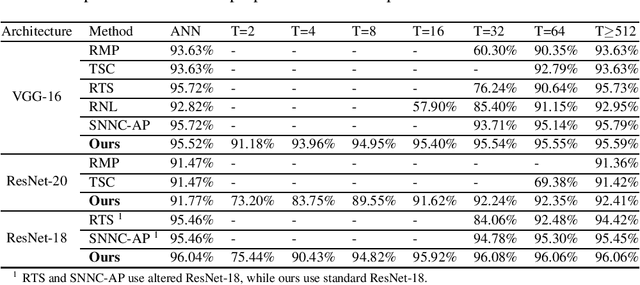
Abstract:Spiking Neural Networks (SNNs) have gained great attraction due to their distinctive properties of low power consumption and fast inference on neuromorphic hardware. As the most effective method to get deep SNNs, ANN-SNN conversion has achieved comparable performance as ANNs on large-scale datasets. Despite this, it requires long time-steps to match the firing rates of SNNs to the activation of ANNs. As a result, the converted SNN suffers severe performance degradation problems with short time-steps, which hamper the practical application of SNNs. In this paper, we theoretically analyze ANN-SNN conversion error and derive the estimated activation function of SNNs. Then we propose the quantization clip-floor-shift activation function to replace the ReLU activation function in source ANNs, which can better approximate the activation function of SNNs. We prove that the expected conversion error between SNNs and ANNs is zero, enabling us to achieve high-accuracy and ultra-low-latency SNNs. We evaluate our method on CIFAR-10/100 and ImageNet datasets, and show that it outperforms the state-of-the-art ANN-SNN and directly trained SNNs in both accuracy and time-steps. To the best of our knowledge, this is the first time to explore high-performance ANN-SNN conversion with ultra-low latency (4 time-steps). Code is available at https://github.com/putshua/SNN\_conversion\_QCFS
 Add to Chrome
Add to Chrome Add to Firefox
Add to Firefox Add to Edge
Add to Edge